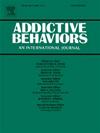Patterns of substance use on a given day in a national sample of U.S. young adults
IF 3.6
2区 医学
Q1 PSYCHOLOGY, CLINICAL
引用次数: 0
Abstract
Introduction
Young adulthood constitutes a period of substance use risk and many young adults engage in use of more than one substance. While existing work has examined young adult co-use of substances at the day-level, there has not been a comprehensive investigation of day-level substance use that considers mode and intensity of use in a national sample of U.S. young adults.
Methods
Individuals were eligible through participation in the nationally-representative Monitoring the Future study in 12th grade in 2018 and reporting past 30-day drinking in 12th-grade. Respondents completed a 14-day daily study in 2019 (n = 911 individuals; modal age 19). Days on which individuals reported alcohol, cannabis, and/or nicotine/tobacco use (n = 3,086 days and 590 individuals) were examined. Latent class analysis was used to identify patterns of substance use at the day-level with stress, boredom, loneliness, and type of day as covariates.
Results
Six patterns of substance use days were identified: Vaping Nicotine (33.69 %), Cannabis Smoking (23.49 %), Alcohol Only (17.10 %), Cannabis Vaping (11.72 %), Multiple Combustibles (7.28 %), and Multimodal Cannabis (6.72 %) days. Stress and boredom were greater on Multimodal Cannabis days compared to most other substance use days. Alcohol Only days were characterized by lower levels of stress, boredom, and loneliness and a greater probability of being a special occasion or a weekend compared to other substance use days.
Discussion
This study identified heterogeneous patterns of substance use behaviors among U.S. young adults. Understanding these patterns is important for developing intervention strategies that are responsive to specific substance use on a given day.
在美国年轻人的全国样本中,某一天的物质使用模式
青年期是物质使用的危险期,许多年轻人使用一种以上的物质。虽然现有的工作已经检查了年轻人在一天的水平上共同使用物质,但在美国年轻人的全国样本中,还没有对一天的物质使用进行全面的调查,考虑到使用的模式和强度。方法:个体通过参加2018年全国代表性的12年级监测未来研究,并报告12年级过去30天的饮酒情况,获得资格。受访者在2019年完成了一项为期14天的每日研究(n = 911人;莫代尔19岁)。对个人报告使用酒精、大麻和/或尼古丁/烟草的天数(n = 3,086天,590人)进行了检查。使用潜类分析以压力、无聊、孤独和日类型作为协变量来确定日水平的物质使用模式。结果确定了6种物质使用模式:尼古丁(33.69%)、大麻吸烟(23.49%)、酒精(17.10%)、大麻雾化(11.72%)、多种可燃物(7.28%)和多种模式大麻(6.72%)。与大多数其他物质使用日相比,多模式大麻日的压力和无聊更大。与使用其他物质的日子相比,只喝酒的日子的特点是压力、无聊和孤独程度较低,而且更有可能是一个特殊的场合或周末。本研究确定了美国年轻人药物使用行为的异质模式。了解这些模式对于制定针对某一天特定物质使用情况的干预策略非常重要。
本文章由计算机程序翻译,如有差异,请以英文原文为准。
求助全文
约1分钟内获得全文
求助全文
来源期刊

Addictive behaviors
医学-药物滥用
CiteScore
8.40
自引率
4.50%
发文量
283
审稿时长
46 days
期刊介绍:
Addictive Behaviors is an international peer-reviewed journal publishing high quality human research on addictive behaviors and disorders since 1975. The journal accepts submissions of full-length papers and short communications on substance-related addictions such as the abuse of alcohol, drugs and nicotine, and behavioral addictions involving gambling and technology. We primarily publish behavioral and psychosocial research but our articles span the fields of psychology, sociology, psychiatry, epidemiology, social policy, medicine, pharmacology and neuroscience. While theoretical orientations are diverse, the emphasis of the journal is primarily empirical. That is, sound experimental design combined with valid, reliable assessment and evaluation procedures are a requisite for acceptance. However, innovative and empirically oriented case studies that might encourage new lines of inquiry are accepted as well. Studies that clearly contribute to current knowledge of etiology, prevention, social policy or treatment are given priority. Scholarly commentaries on topical issues, systematic reviews, and mini reviews are encouraged. We especially welcome multimedia papers that incorporate video or audio components to better display methodology or findings.
Studies can also be submitted to Addictive Behaviors? companion title, the open access journal Addictive Behaviors Reports, which has a particular interest in ''non-traditional'', innovative and empirically-oriented research such as negative/null data papers, replication studies, case reports on novel treatments, and cross-cultural research.
 求助内容:
求助内容: 应助结果提醒方式:
应助结果提醒方式:


